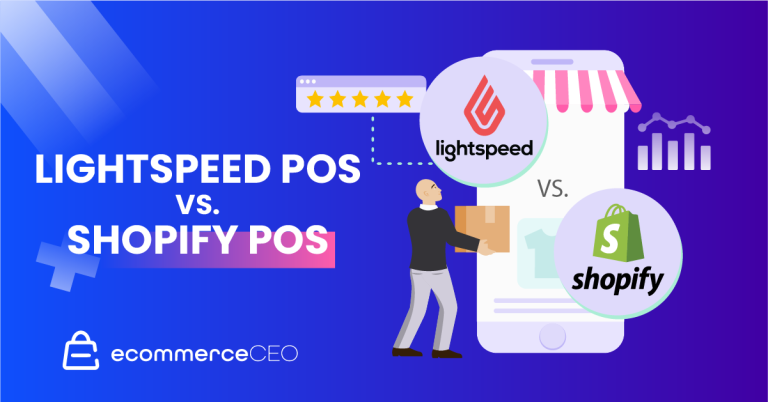Last Updated on February 14, 2022
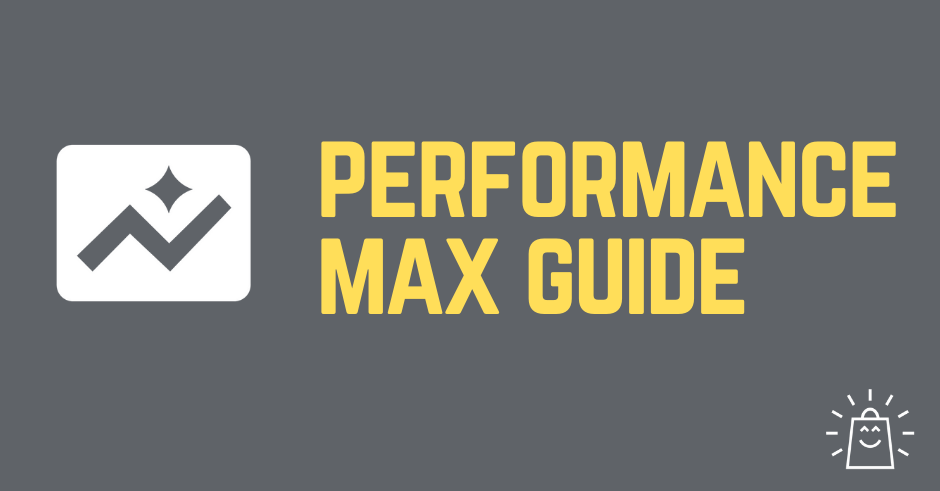
Performance Max campaigns are taking the world of Google Ads by storm.
pMax campaigns were only announced a few months ago, but right now they are on top of the to-do list for many businesses and services providers.
In this article, we’ll show you why that is. We’ll get you up to speed with how Performance Max works and how you can integrate them in your Google Ads approach.
Table of Contents
What is Performance Max?
Performance Max is the Frankenstein monster of Google Ads.
Instead of using specific ad formats, like Search or Shopping Ads, Performance Max Ads are able to show in every channel Google is able to target.
That means Search, Shopping, YouTube, Display, Search, Discover, Gmail, and Maps.


If you’re not very familiar with Google Ads, this might sound great. Because now you can show ads in all those places, with a single campaign that takes less work to set up and manage!
But if you do have a bit of experience running campaigns, all alarm bells are ringing 🚨
Why should you care about Pmax?
Google only announced Performance Max in November of 2021.
And now they’ve already confirmed that Performance Max will replace Smart Shopping by September of 2022.
This is pretty remarkable. Because if you’ve ever been on the phone with a Google rep in the last couple of years, you might have noticed how hard they’ve tried to sell Smart Shopping.
Only to switch once again.
Performance Max is the next step in the evolution we’ve seen play out in the last few years.
That evolution consists of Google using machine learning to take more control over what your ad looks like, when, and who it is shown to.
Before, you had the option to turn off things like Search Partners or Display Select with regular Search and Shopping Ads.
But with the launch of Smart Shopping in 2019, that optionality changed.
All of a sudden, your ads were now showing on Shopping, Display, YouTube, and Gmail.
So if you’ve drank the Smart Shopping Kool-Aid, things are about to change and you have to pay very close attention to the rest of this article.
How Do Performance Max Campaigns Work?
Like I mentioned above, Performance Max campaigns (also called pMax) do a lot of things at once.
Think of a combination of a Search, Shopping, Display, and YouTube Ad.
If you’re more familiar with Google Ads, Performance Max basically is a merger of Smart Shopping with Dynamic Search Ads.
In order for Google to be able to do this, you provide them with a product, feed, a bunch of assets like headlines, images, and videos.
Google will then mix and match all of these elements to come up with a different ad depending on the placement.
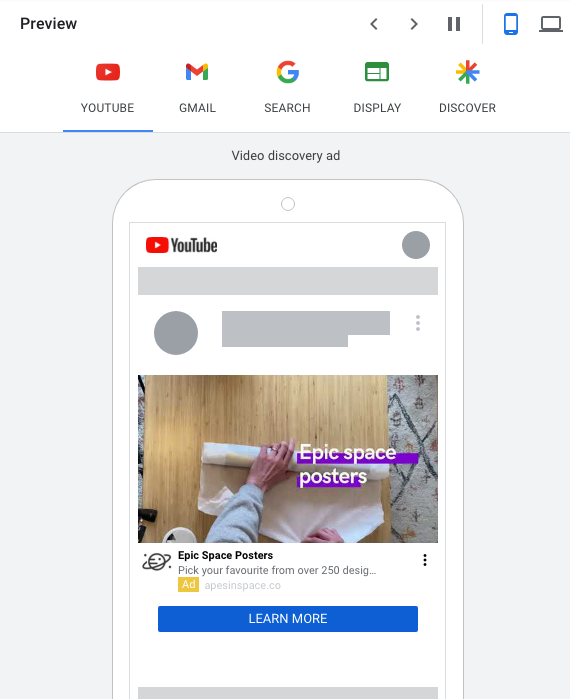

The Preview above shows my Performance Max Ad on YouTube.
Because pMax campaigns do so much, they have a big impact on other campaigns. We’ll look closer into the exact impact later in this article.
What Are the Benefits of Using Performance Max?
To get the benefits of using Performance Max campaigns, where better to look to than the initial Google announcement?
Here is what they claim:
- Increasing conversions and value
- Finding new customers
- Gaining richer insights
- Working together with automation
It’s still the early days for Performance Max campaigns. But from my own experiments, I haven’t seen any of the above play out yet.
To me, the current advantages are fairly limited:
- Potentially more reach: you’re leveraging even more Display-style placements. But this doesn’t always mean better performance.
- Less work: since Google is handling so much behind the scenes, there is not a lot of work left to do.
Downsides of Performance Max Campaigns?
The downsides of Performance max share a lot with my criticism of Smart Shopping.
Little Or No Insights
If Smart Shopping was a black box, Performance Max is even blacker.
At this moment, there is very little insight into how the budget is allocated. Both on the different channels, or on the type of visitors (prospecting vs remarketing).
With the impact pMax has on Search (see later in the article), there is also little insight on where cannibalization is happening.
All this results in a scary situation for advertisers. Either you’ve got great results and blindly increase the budget until it stops. Or your campaign suddenly tanks and you’ve got no idea why that is.
Cannibalization
Since Performance Max covers a much wider range of ads, launching it can have a big impact on your existing campaigns.
If you’re not paying close attention, it will cannibalize some of your other campaigns, and claim credit for the sales.
This makes it a lot harder to judge the incremental value of Performance Max.
I’ll further discuss the exact impact Performance Max has on your existing account. But for now, I’ll leave you with this chart:


Can you guess when this advertiser launched a Performance Max campaign?
Visibility on Keywords or Placements
Similar to Smart Shopping, Performance Max doesn’t offer any insights into which search terms are being triggered by the campaigns.
This can hurt your ability to cut wasteful spending on irrelevant searches or optimize your campaigns.
For placements, they have launched a report, which can help to exclude certain placements via account level exclusions.
Even though we can’t see search terms, Google is working on Account level negative keywords. So if you have keywords lists from previous campaigns, it can be well worth adding them!
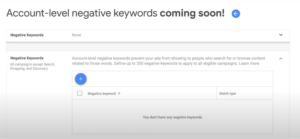

No access via Google Ads editor
Google Ads Editor doesn’t support Performance Max campaigns. They simply will not show up in your campaign list.
If you want to set up a lot of asset groups or have some detailed location targeting to implement, this currently means a lot of manual work.
But I’m sure Google is working on an update for this. Recently support via the Google Ads API was enabled and the campaigns are now visible in Google Data Studio.
Impact of Performance Max on Other Campaigns?
One of the most important things to discuss when it comes to pMax is the impact it will have on existing campaigns.
To do that, take a look at the chart below.
It shows the impact of Performance max on the campaigns in the first column, and which campaign actually enters the auction.
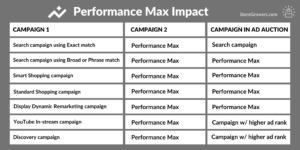

To me, the most important part of that chart is the impact on branded Search Ads.
If you have both a Search Ads campaign that uses phrase or broad match keywords, and a Performance Max campaign, the latter will probably show.
That means that if you have Search Ads campaigns that target your branded keywords, depending on the keyword match type, Performance Max will take credit for those conversions.
Since branded searches usually are the most profitable campaign that you can run, pMax will look very good, without actually doing anything new.
So you want to make sure that your branded search is set up in such a way that this isn’t possible.
According to the table above: either by having exact match keywords or if you have other keyword match types, by having a higher ad rank.
Since we can’t see keywords or quality scores for pMax campaigns, you’ll be guessing if your campaign is showing up or not.
How to Create a Performance Max Campaign
It’s become clear that Performance Max campaigns work very differently from other campaigns.
That’s also true for their setup. They are also a bit different to set up.
So let’s look at how to set up a Performance max campaign, step by step.
1 – Pick a campaign objective
When you create a new campaign, Google always asks you about your campaign per marketing objective.
Select the last option in the list, “Create a campaign without a goal’s guidance”:
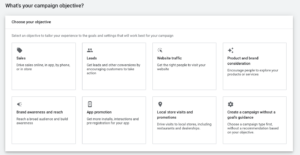

2 – Pick a campaign type
Next, you can select a Performance Max campaign.
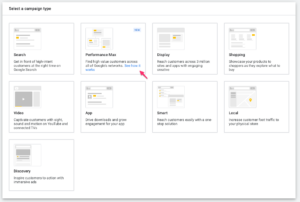

3 – Select conversion goals
Next, you need to select the conversion goals that are used for campaign optimization.


Pay close attention to this step. Be sure to remove non-essential goals. This avoids duplicate goals or tracking useless things like newsletter signups.
If you would like to remove a goal, simply click the three dots on the right and click “Remove goal”
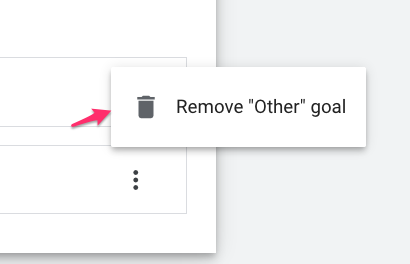

4 – Budget & bidding
The next section of the setup is where you set your budget and bidding strategy.
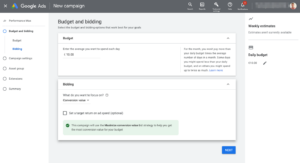

If you’re not sure what budget to pick, here is a budget recommendation from Google:
Try an average daily budget of at least three times your CPA or cost/conv. for the conversion actions selected for your campaign
Available smart bidding strategies are Maximize Conversions and Maximize Conversion Value. Both have the option to set a target CPA, target ROAS, so that gives you additional levers to pull.
5 – Campaign Settings
In this step, you can make some additional adjustments to your campaign like selecting the locations you want to target.
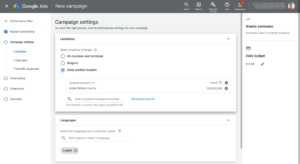

Since pMax is also targeting Search, you also need to select the language(s). This is very different from Shopping campaigns, where Google would use all products that are approved for a specific country.
The last import setting is Final URL expansion.
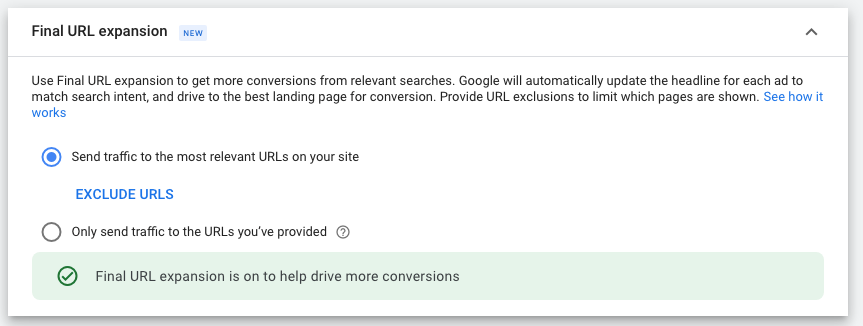

This option basically asks you whether you want to add Dynamic Search Ads to your campaigns.
If you select “Send traffic to the most relevant URLs on your site”, Google might look beyond the Final URL in your ad or product URLs in your feed for a page on your site that matches the intent better.
Use the Exclude to avoid pages like your About us page showing up as the main URL. (You can add them as ad extensions)
We’ll explore this feature in more detail in the optimization section of this article.
6 – Create Asset Group(s)
Next, we need to set up one or more asset groups.
This is something that’s pretty different compared to other campaigns.
An asset group is basically an ad group, product group, and advertisement packed into one.
Listing group
First, you have to select the products you want to include in this asset group. By default, it uses all products that are in your feed.
To change that, click the pencil icon to select based on the same criteria we know from other Shopping campaigns.


Assets
When you open up the asset menu, you’ll see a lot of resemblance with Smart Shopping Ads.
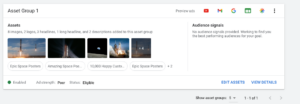

You give Google a bunch of creative assets, and they combine it in different ways depending on the placements.
Here is what you need:
- Headline: 3-5 headlines
- Long headline: 1-5 long headlines
- Description: 2- 5 description texts
- Images: at least 1 square and one landscape image
- Logo: at least 1 square logo, others are optional
- YouTube video: not required, up to 5 videos of min 10 seconds
I listed the minimum for each ad. But ideally, you want to provide a bunch of assets Google is able to combine. Especially in terms of the images, it’s important to provide variation in dimensions and content.
If you’re interested, here are all potential assets you can provide for Performance Max:
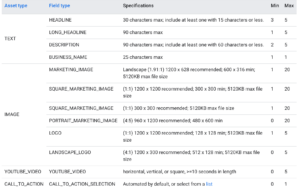

When you start filling in your text assets, Google will pull headlines and descriptions from your other ads, which makes it pretty easy to re-use them.
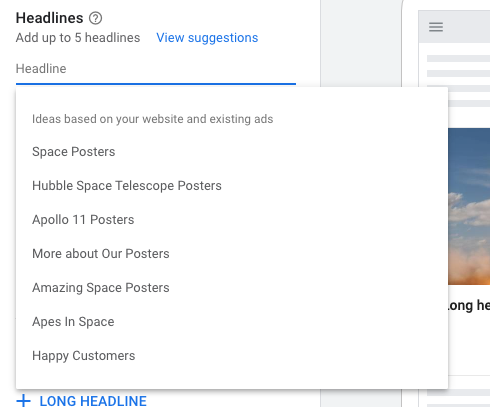

Audience signal
Audience signal is another new thing that has a new name but actually has pretty familiar content.
Google says that adding an audience signal will help steer its automation more quickly towards the right customers.
Here is what it looks like for my store:
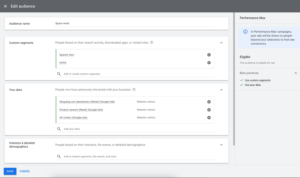

An audience signal is a combination of:
- Custom segments
- Your own audiences: these are your remarketing audiences & customer match lists
- Interest & demographics: in-market & affinity audiences
What you select in this list won’t be the only targeting criteria. It just gives Google a jumpstart at understanding what your audience looks like.
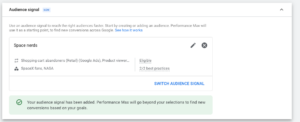

7 – Extensions
The last step of setting up a Performance Max campaign is adding your ad extensions.
Because your ads are also appearing as Search Ads, this is really important to grab all the real estate you can.
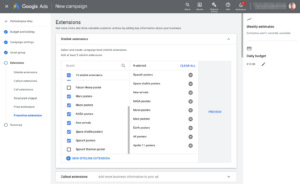

Not all ad extensions are available yet. But you can already add sitelinks, callout extensions, structured snippets, and promo extensions when appropriate.
When those are added, your campaign is ready to go!
Performance Max Campaign Optimization
When I started writing this section, I had a sentence in place that this section would be pretty light and that we would be adding over time. But now that I’ve finished writing, I’m actually surprised at how much we can already do!
When we talk about how to get better results or how to scale Performance Max campaigns, it’s important to stress that it’s still the early days.
We’re in the middle of running tests. And I’m sure that on the Google side, still, a lot is changing.
But from looking at the intent with this campaign type, it’s already clear that there are a lot of parallels with Smart Shopping optimization.
We’ll cover these more commons optimization tactics last, and start with some existing tips, ideas, and wild guesses first 🤓
Quick note: if you love geeking out about this stuff as well, check this new thing we’re launching!
Performance Max campaign structure
One of the key differences with Smart Shopping is that you’re able to create multiple Asset groups per campaign.
In fact, you’re able to have up to 100 assets groups in a Performance Max campaign:
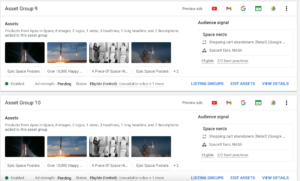

So I’m guessing these Assets groups really do behave like Ad groups. (Of which you can have 20,000 in a campaign btw)
This opens the door to having a single campaign, but building out multiple assets groups to target different parts of your product catalog, a different theme, or a different audience.
Then you can customize each asset group with different text, images, and videos, a different Final URL, and different products.
One Google recommendation to keep in mind is to minimize listing group overlap:
We recommend that each asset group target different products (i.e., Products A-L in Asset Group 1 and Products M-Z in Asset Group 2).
This is in line with one of our iron rules: one thing, one campaign.
So I think the multiple asset groups is probably one of the biggest levers we have available.
Asset optimization
Besides multiple asset groups, we can also improve the assets within each asset group.
Here is an overview of the Asset detail report, which looks a lot like the report for Responsive Search Ads:
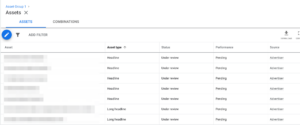

All your assets, text, images, and videos will be evaluated. You’ll see the result in the Performance column.
There are four potential values:
- Low: low performing against all other assets of the same type across properties.
- Good: assets perform well enough
- Best: one of the highest performers of all assets
- Pending: not enough data yet (you’ll need > 5000 impressions per asset)
The goal is to get rid of the Low performing ones and have at least multiple “Best” assets for each asset type.
Note that a specific asset type performance is different from “Ad Strength”. This last one is an indicator that Google gives depending on the amount and variety of assets that you’ve provided in your asset group.


If this works similar to other accounts, a poor ad strength doesn’t automatically mean you’ll see bad results.
One other interesting observation from the asset type report above is the last column Source.
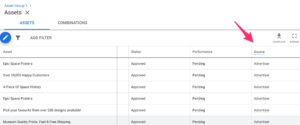

In this report, the source is Advertiser, it basically are all assets that I provided.
But that brings the question of whether there are assets that are NOT provided by the advertiser?
To explore that rabbit hole, let’s talk about video!
Performance Max Videos
If you don’t add a video to your asset group, Google will automatically generate them.
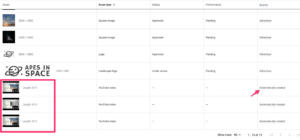

If you’re wondering if they’re any good, have a look at what was added to my campaigns:


I have (mostly) stayed away from YouTube Ads because it’s so hard to produce good creative.
So imagine how much it pains me to spend money on this type of garbage.
The only way to stop showing these auto-generated videos is to add a YouTube video that can show instead.
If you have the resources, I would recommend creating your own video, instead of trusting that Google will put something together that represents your brand and products well.
Since this will open YouTube Ads to a lot of advertisers, I expect a lot to happen here in the coming months.
URL Expansion
When Google says URL expansion, they are talking about going beyond the Final URL and the individual product URLs.
In the setup section, I mentioned the ability to turn this on or off. But actually, there are 3 options:
- URL expansion ON, no exclusions
- URL expansion ON, with exclusions
- URL expansion OFF
Note: URL expansion is OFF if you’re not targeting All products in the listing group.
I would mainly test #2 & #3. As part of the exclusions, I would put any non-commercial pages on my site like about us, FAQ, shipping details, etc.
You might want to use them in your sitelinks, but not as the main URL of your ad!
Campaign Priority & Performance Max
Performance max takes priority over all Shopping campaigns, both Smart and Standard Shopping.
But digging through the Google Ads API docs, I found an interesting line on campaign priority:
Campaigns with numerically higher priorities take precedence over those with lower priorities.
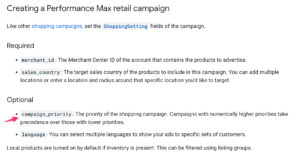

I think this refers to having multiple pMAx campaigns in an account and then using different campaign priority settings to prioritize one over the other.
This opens the door for more complex account structures and our beloved tiered bidding tactic!
Performance Max Placements
Google has a predefined report inside of Google Ads called the “Performance Max campaign placements”.
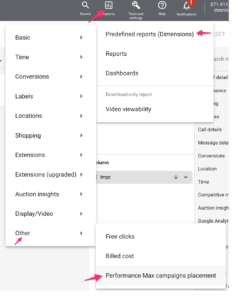

But in its current state, the report is either very light on details, or it doesn’t work very well.
The only Column that’s available is Impressions.
Check this example:
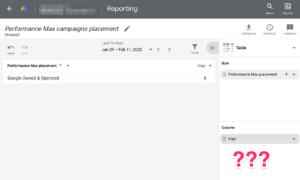

We can see “Google Owned & Operated” placements, with 6 impressions. Not really that helpful in a campaign that got over 700 clicks. So much for promising more insights!
But I suspect we’ll see more metrics and more accurate data in the coming months.
That covers the optimization details that are unique to Performance Max campaigns. Luckily there are a bunch of tactics we can leverage from other campaign types.
Google Merchant Center business settings
In Google Merchant Center, you can upload your logos and business colors.
That makes sure that at least some part of your branding is used in your ads:
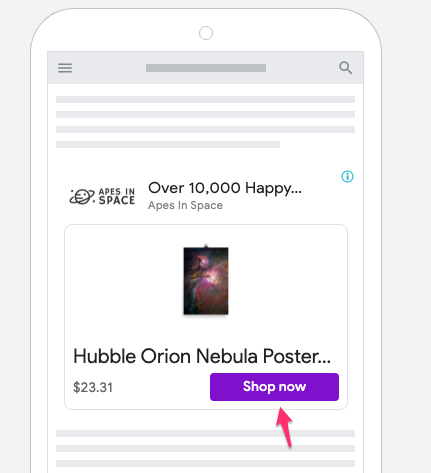

Leverage Goals Deep in the funnel
Performance Max isn’t just for retailers. It can also be leveraged for lead gen campaigns.
One of the recommendations Google has for those advertisers:
If using Maximize-conversions or tCPA bid strategies, select the deepest funnel conversion action that has sufficient frequency and set the tCPA accordingly.
This is something we’ve seen in Smart Shopping as well.
We’ve tried to get more data into Google Ads by using start checkout or add to cart as the main goal.
Even with all the necessary measures to accomplish this (discounted values or more aggressive ROAS targets), we haven’t seen this result in the algorithm getting any better as a result of more data.
So it’s interesting to see a very similar recommendation from Google about focussing as deep in your funnel as possible.
No doubt we’ll try goals higher in the funnel at some point, but it’s not on top of our list.
Adding Negative keywords
With Performance Max you can’t add negative keywords manually to your campaigns. But similar to Smart Shopping, you can add them by going through Google support.
Feed optimization
While there is not much to change on the actual Shopping Ads, we still have a lot of power over what we put in the feed.
So like Smart Shopping, product feed optimization is very important.
First, that means cleaning up your feed and making sure you’ve fixed the warning in Google Merchant Center.
The second part is to bring in the necessary info you need to organize your campaigns via custom labels.
Then the true feed optimization can start with updating product titles, descriptions, images, etc.
Bid adjustments
The last section of our Performance Max optimization is about the bid adjustments like ad scheduling or location targeting.
Since they’ve been around for a long time, I’m not going into detail here.
Performance Max Results (So Far)
Since the Performance Max was released so close before the 2021 holiday season, we wisely stayed away from it for all our clients.
So we’ve only started really testing for about 6 weeks. With bigger products catalogs, and giving it more budget.
Results so far have been relatively good for clients where we were pushing Smart Shopping hard.
For one client with well-built Search Ads campaigns, Performance Max also got good results, but it really came at the cost of the existing campaigns.
Because they have been honed over many years, it’s understandable that pMax isn’t able to get up to par yet.
So while the early small tests seem good, the verdict is still out!
Who Should Use Performance Max?
If you’re still with me, your head is probably spinning from all the things you should look into.
So to finish, I want to add my recommendation on who should use Performance Max.
If you’re just starting out, or you’re spending less than 1k/mo, stay away from Performance Max. Because of your limited budget, you need to take more control over where your ads appear.
If you run more advanced Display or YouTube Ads campaigns, Performance Max might cause all sorts of trouble.
For everyone else, Performance Max might be good, but you need to test.
During those tests, the most important part is to safeguard your branded Search from cannibalization.
And when you’re comparing before/after results, make sure you look at the changes in your whole account, not just Performance Max vs your Standard or even Smart Shopping campaign.
That said, I believe that right now it’s too early for Performance Max to lead the account.
We’re going to use all of the coming months to continue to heavily test and figure out scaling strategies.
But I’m worried, especially for the clients where we’re moving heavily into Smart Shopping.
We’ve taken a hit, we got addicted and now Google is promising an even better feeling. Because it’s easy, it will be a logical next step to switch to Performance Max.
But as a business with a mission to help small ecommerce businesses, we owe it to our clients to stay clean and objective.
Curious to hear your thoughts on Performance Max in the comments 🙂


